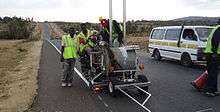Road marking machine



A road marking machine (or road marking equipment, pavement marking equipment) is a mechanical device that makes road markings on paved surfaces. Road marking machines usually can be divided into three categories: thermoplastic paint, cold paint and two-component paint type, depending on the coatings.
Classification
Depending on the coating, road marking machines can be divided into thermoplastic paint, cold paint and two-component paint type. Depending on the degree of automation, Road marking machines can also be divided into driving, self-propelled, and hand-pushed types.[3] The driving type can be further categorized by size.
Coatings
Road markings are applied using thermoplastic material, cold plastic paint, heated paint and field reactive two component materials. Thermoplastic material is applied hot and sets on laying. It has good durability and is suitable for use on all roads. Cold plastics are supplied in single or multi-component forms. The product is laid on the carriageway and a cohesive film is formed by chemical activity. Regular paints, whether applied hot or cold, are formulated specifically to bond to the road surface, and hold glass beads that are applied immediately into the wet paint (for night time reflectivity). Regular paints are still used world wide and provide the fastest method for applying lines. These paints do not have the life expectancy of thermoplastics or field reactive materials.
Thermoplastic markings
Thermoplastic marking (also called hot melt road markings) refers to thermoplastic road marking lines. These lines are frequently made reflective, and can also be made exceptionally thick to produce a rumble strip effect.[4] Thermoplastic paint, or hot melt road marking paint, is mainly composed of synthetic resin, glass beads, colored pigments, timber fillers, and other additives. The Thermoplastic marking coating sets quickly. The melt adhesion of a synthetic resin makes hot-melt paint adhere strongly to the road surface. wikt:additive:Additives in the coating paint increases the coating plasticity, improving the anti-settling, anti-pollution, anti-tarnish. Thermoplastic marking paint is most commonly produced in yellow and white. The white marking paint mainly contains titanium white, zinc oxide, lithopone, while the yellow paint is mainly heat-yellowing lead. The filling materials of road paint can affect the mechanical strength, abrasion resistance and hue of the coating film. The particle size of the paint powder influence the flow, sedimentation and also the surface processing. Glass beads are mixed in or applied to the surface in order to improve the visibility at night, and improve brightness and durability of the marking. The glass beads are colorless, and function as retroreflectors.
Construction methods
Hot melt road marking paint is a solid powder at room temperature. The thermoplastic paint is melted in a specialized machine called a thermoplastic heater-mixer, before being transferred into the paint tank of a marker. Larger marking machines may have internal heater-mixers. The molten coating is introduced into an insulated marking bucket. The market bucket leads to a marking shoe that applies the material. Moving the shoe forward pulls a thin layer of paint onto the road. The thickness of this layer is controlled by the gap between the marking shoe and the road. A specialized attachment can spread an even layer of glass beads onto the paint as it is deposited.
Machine marking types
Air spray is a method of marking that uses compressed air to spray the paint onto the road surface. The finely atomized paint produces a thin and smooth layer, but the rebounding air flow causes significant paint scattering. This produces somewhat sloppy markings.
High-pressure airless spraying uses a high-pressure airless pump to spray the paint. The atomized paint is not so fine and smooth as air spray, but there is no high speed air flow to scatter any rebounding paint. The marked lines are neat. This method can apply paints of high viscosity, and apply relatively thick layers in a single pass.
Auxiliary equipment
Other equipment is often used with road marking machines. The main auxiliary equipment includes thermoplastic paint pre-heaters, hand-push pre-markers and road marking removers. Thermoplastic paint pre-heater is used to melt the solid powder coating into a viscous liquid, providing a steady supply of paint to the marking machine. Pre-markers are used to draw a field sketch in advance to avoid faulty marking. Road marking removers are used to remove old or incorrect markings. Large self-propelled[5] machines usually do not need any support equipment, as equivalent functionality is built in.
See also
- Traffic signs
- Road surface marking
- Paint (Road marking paint)
- Zebra crossing
- Pedestrian crossing
- Lane
References
- ↑ "Kenya Customer Feedback the Information of DY-STM". Retrieved Mar 2012. Check date values in:
|access-date=(help) - ↑ "Operators Training of Road Marking Machine in Bahrain". Retrieved Dec 13, 2012.
- ↑ "Driving-type, Self-propelled, Hand-push, What do These Words Mean?". Retrieved Dec 13, 2013.
- ↑ "The Thermoplastic Rumble Strip Process". Traffic Lines, Inc. Retrieved 25 July 2015.
- ↑ "Self-propelled road marking machine".